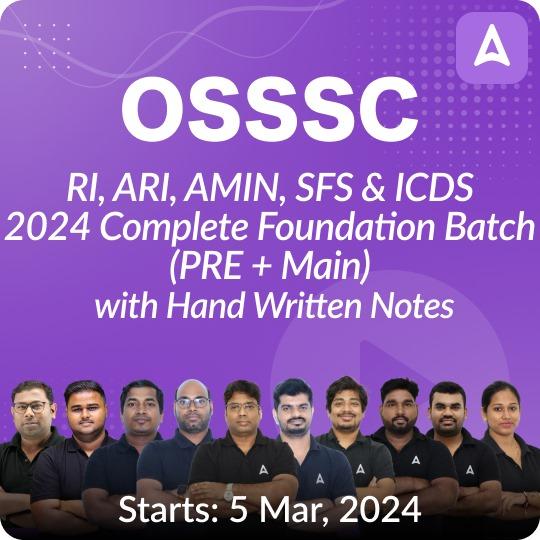The top 30 Committees and Commissions in India before Independence, suitable for generating multiple-choice questions (MCQs) for OSSSC LSI (Laboratory Support Inspector) and Forester FG (Forest Guard) exams:
- Who introduced the Charles Wood Despatch in India?
a) Lord Dalhousie
b) Charles Wood
c) Lord Rippon
d) Lord Curzon
Answer: b) Charles Wood - In which year was the Charles Wood Despatch introduced?
a) 1854
b) 1882
c) 1917
d) 1935
Answer: a) 1854 - Which Commission was introduced to promote western education in India?
a) Hunter Commission
b) Sadler Commission
c) Charles Wood Despatch
d) Sapru Commission
Answer: c) Charles Wood Despatch - Who was the Viceroy of India when the Hunter Commission was introduced?
a) Lord Dalhousie
b) Lord Rippon
c) Lord Curzon
d) Lord Mountbatten
Answer: b) Lord Rippon - The Sadler Commission was delegated to investigate the condition of which university?
a) University of Bombay
b) University of Delhi
c) University of Calcutta
d) University of Madras
Answer: c) University of Calcutta - In which year was the Sapru Commission introduced?
a) 1854
b) 1882
c) 1917
d) 1935
Answer: d) 1935 - What was the main purpose of the Sapru Commission?
a) Promoting primary education
b) Investigating university conditions
c) Bringing reformation to administration
d) Focusing on unemployment
Answer: c) Bringing reformation to administration - Why was the Simon Commission boycotted by Indian leaders?
a) Due to its composition with entirely British members
b) Due to its recommendation to retain separate communal electorates
c) Due to its focus on provincial elections
d) Due to its recommendation to abolish diarchy
Answer: a) Due to its composition with entirely British members - When was the Election Commission of India formed?
a) 1850
b) 1950
c) 1960
d) 1970
Answer: b) 1950 - What was the slogan chanted by protesters during the Simon Commission’s arrival in India?
a) “Diarchy Must Go”
b) “British Rule Forever”
c) “Simon Go Back”
d) “Long Live British Commission”
Answer: c) “Simon Go Back” - What is the purpose of the Law Commission?
a) Conducting elections
b) Maintaining healthy operations
c) Bringing reformation in laws
d) Supporting backward classes
Answer: c) Bringing reformation in laws - When was the NHRC of India formed?
a) 1950
b) 1960
c) 1970
d) 1993
Answer: d) 1993 - Which Commission focuses on technical changes in the generation of atomic energy?
a) Election Commission
b) Law Commission
c) National Commission for Backward Classes
d) Atomic Energy Commission
Answer: d) Atomic Energy Commission - Who was responsible for setting up the Simon Commission?
a) Lord Birkenhead
b) Clement Atlee
c) M A Jinnah
d) Pandit Nehru
Answer: a) Lord Birkenhead - What was the purpose of the Khosla Commission?
a) Conducting elections
b) Investigating Netaji Subhas Chandra Bose’s death
c) Identifying backward classes
d) Performing state reorganization
Answer: b) Investigating Netaji Subhas Chandra Bose’s death - Which Commission was delegated to pass the reservation rule in academia for backward classes?
a) Election Commission
b) Law Commission
c) Mandal Commission
d) NHRC of India
Answer: c) Mandal Commission - When was the Simon Commission appointed?
a) 1919
b) 1927
c) 1928
d) 1930
Answer: c) 1928 - When was the Sapru Commission introduced?
a) 1854
b) 1882
c) 1917
d) 1935
Answer: d) 1935 - What was the main purpose of the Sadler Commission?
a) Promoting primary education
b) Investigating university conditions
c) Bringing reformation to administration
d) Focusing on unemployment
Answer: b) Investigating university conditions -
- The Simon Commission was appointed to review and recommend reforms related to which significant aspect of governance?
a) Judiciary
b) Education
c) Civil Services
d) Constitution
Answer: d) Constitution
- The Simon Commission was appointed to review and recommend reforms related to which significant aspect of governance?
- Wood’s Despatch, often regarded as the Magna Carta of English education in India, was associated with which year?
a) 1802
b) 1854
c) 1900
d) 1947
Answer: b) 1854 - The Hunter Commission was appointed to investigate which major event in Indian history?
a) Partition of Bengal
b) Jallianwala Bagh Massacre
c) First War of Independence
d) Plague outbreak in Bombay
Answer: b) Jallianwala Bagh Massacre - According to which legislation was the establishment of a Public Service Commission provided for in each Province?
a) The Government of India Act, 1919
b) The Indian Independence Act, 1947
c) The Government of India Act, 1935
d) The Constitution of India, 1950
Answer: c) The Government of India Act, 1935 - The Indian Universities Commission, also known as the Curzon Commission, was appointed by which Viceroy of India?
a) Lord Curzon
b) Lord Dalhousie
c) Lord Ripon
d) Lord Mountbatten
Answer: a) Lord Curzon - The Montagu-Chelmsford Reforms Commission is associated with which significant constitutional development in India?
a) Morley-Minto Reforms
b) Government of India Act 1919
c) Simon Commission
d) Cabinet Mission Plan
Answer: b) Government of India Act 1919 - What were the recommendations of the Lee Commission regarding the recruitment for Superior Civil Services in India?
a) 20% British, 20% Indians, 60% provincial service
b) 40% British, 40% Indians, 20% provincial service
c) 20% British, 40% Indians, 40% provincial service
d) 40% British, 20% Indians, 40% provincial service
Answer: b) 40% British, 40% Indians, 20% provincial service - Which year did the Lee Commission propose its recommendations for the recruitment in Superior Civil Services in India?
a) 1910
b) 1924
c) 1935
d) 1947
Answer: b) 1924 - Why is the Lee Commission also known as the Royal Commission?
a) It was established by the British monarchy
b) It proposed reforms to the British Royal Family
c) It focused on recruiting British individuals for civil services in India
d) It was headed by a member of the British Royal Family
Answer: c) It focused on recruiting British individuals for civil services in India - What was the purpose of the Sargent Scheme?
a) To outline the future development of literacy and education in India
b) To propose reforms in the Indian judicial system
c) To address post-war economic challenges in India
d) To establish a new administrative structure in India
Answer: a) To outline the future development of literacy and education in India - What was the impact of the Simon Commission on Indian politics?
a) It led to the immediate attainment of Indian independence
b) It resulted in the abolition of separate communal electorates
c) It paved the way for the Government of India Act 1935
d) It caused a rift between the Congress Party and the Muslim League
Answer: c) It paved the way for the Government of India Act 1935





